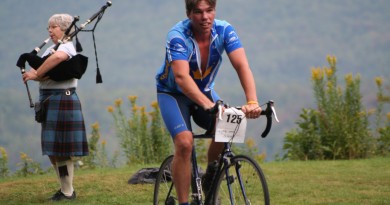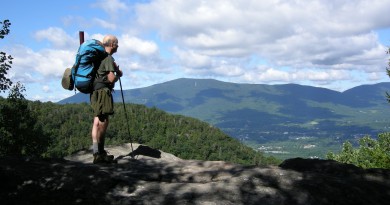For Love, Not Money: Racing Sled Dogs
By
Phyl Newbeck
Posted March 30th, 2010
Ellie was starting to whine. Some of the other dogs had already been placed in their harnesses, but Elizabeth Rankin hadn’t gotten to the two-year-old Alaskan husky yet. When she did, Ellie practically jumped into the harness. There is no distinct order for harnessing the dogs, but there is definitely one for hooking them to the sled and Ellie, a veteran of Rankin’s pack, was the first to be tethered to the line.
Rankin started running sled dogs in 2004, after an internship at UVM with Ingrid Bower. Bower invited her to see a litter of puppies being born. Afterwards, Rankin helped hook up 12 dogs to an ATV for a run on the dirt roads of Underhill. “It was gorgeous,” Rankin said. “I couldn’t get enough.” Rankin spent the two subsequent summers training in Alaska, doing a second internship with Bower in between. She later adopted two of the dogs she trained in Alaska, and in 2006 she was able to adopt her own dogs in Vermont. For eighteen months, Rankin and her boyfriend lived in a deer camp in Westford, with no electricity or running water, since no rental property would allow them to stay with four dogs. The pair was finally able to buy a house in 2007 and now live in Starksboro, with eight dogs and one poor, beleaguered cat. Most of the dogs were adopted from homes where they didn’t fit in.
For two years, Rankin competed in 15- and 20-mile dog sled races, but this year she is making the jump to 30-mile events. On the day we met, she was about to embark on a 20-mile training run at Little River State Park. A route she had previously mapped out had to be changed since the dogs seemed spooked by some of the snow-laden trees that dipped over the path. Although Rankin sometimes provides tours and helps out with other touring operations, her passion is racing, and touring is solely a means of getting a little bit of extra income.
Rankin tries to keep the dogs occupied year round with a big, fenced-in backyard obstacle course and long hikes. The dogs also enjoy chasing the ATV that Rankin uses for early season training. When we met in late January, the dogs had already logged 450 training miles. Rankin starts running the dogs in mid-October, when the weather gets cool, beginning the process with 3- to 4-mile runs and working up to 12-mile rides with the ATV. When the snow falls in December, training begins in earnest. At first, a 12-mile run took one hour and 45 minutes. By late January, that time was down to one hour and 20 minutes. By the end of February, the team had dropped another five minutes off their pace.
On this January day, some of the dogs wore little green booties to protect their feet from the snow which had turned crunchy and granular. Others were protected by a waxy, petroleum jelly spread between their toes. Since booties cost $1.50 a piece (Rankin has tried to make them herself, but was unsuccessful) and only last for two runs, the booting-up process can become quite expensive. Most dogs only wore boots on their rear paws since those are the driving paws, while the forepaws do the steering and stabilizing.
The dogs weigh an average of 50 pounds in the winter (more in the summer), and need to take in 4,000 to 5,000 calories per day, often burning more than that. Rankin estimates that she spends close to $200 a month on food, which is supplemented by donated road kill; venison treats are very popular with the team. Another major expense is gasoline. Rankin believes she spends almost $300 a month in gas to get to her training sites. In addition, she has gone through a number of vehicles. Initially she purchased small trucks, but found that the box that houses the dogs puts so much wear and tear on the vehicles that she was forced to purchase a larger vehicle. “You are working to support your habit,” she said, “and your habit doesn’t bring a lot of money in unless you do tours. You’re doing it for the love of the dogs.”
Ingrid Bower, a UVM librarian, has been running dogs for over thirty years. In the mid-‘90s, she began hosting an internship for UVM students who received credit for working with the dogs at her Underhill home. Some years, up to five students partake of the internship, although Bower prefers to have no more than two or three. Many of her former interns, like Rankin, continue to train dogs.
This year Rankin signed up for four races and a fun run. Unfortunately, the race at Burke Mountain at the end of February was cancelled due to lack of snow. But Rankin managed to turn in stellar performances at a few other New England Races. At the Wonalancet Fun Run in New Hampshire on January 23, she came in third out of 12, running five dogs in a four- to six-dog class. On February 6 she went to the 100-Mile Wilderness Race in Greenville, ME. She entered the 30-mile race and placed seventh out of 18 teams, running six dogs in the six- to eight-dog class. Her final race of the season was the Can-Am Crown on March 6 in Fort Kent, ME. After being second on the waiting list, she was finally accepted into the 30-mile race and placed twelfth out of 31 teams, running six dogs in the five- to six-dog class. Last year she was the winner in the Stratford Nighthawks Race in New Hampshire. Unfortunately, she did not have a chance to defend her title since this year’s race was also cancelled.
Rankin has a full-time job as the animal control officer and village officer for the Town of Stowe. In the summer, the job allows her to keep in shape on bicycle patrol. Despite the hours, Rankin manages to find time to run her dogs at least three or four days a week. In the fall, she is able to take them out at night when the weather is cooler. Juggling full-time work and dog sledding is hard, but Rankin wouldn’t have it any other way. She still remembers her first trip to Bower’s Underhill home. “Being around that many dogs was kind of intoxicating,” she said. “I knew I wanted to do this forever.”
Phyl Newbeck lives in Jericho with her partner, Bryan, and two cats. Since the cats have shown no interest in pulling a sled, she enjoyed the opportunity to visit with Elizabeth’s dogs. Phyl is a skier, skater, cyclist, kayaker, and lover of virtually any sport that does not involve motors. She is the author of Virginia Hasn’t Always Been for Lovers: Interracial Marriage Bans and the Case of Richard and Mildred Loving.


